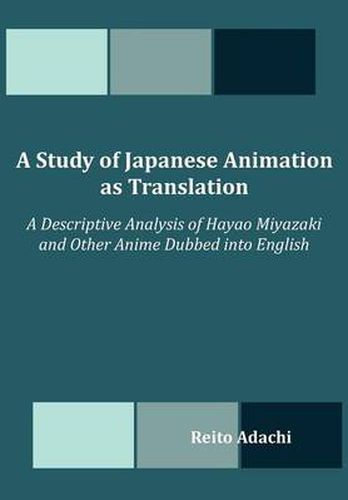Readings Newsletter
Become a Readings Member to make your shopping experience even easier.
Sign in or sign up for free!
You’re not far away from qualifying for FREE standard shipping within Australia
You’ve qualified for FREE standard shipping within Australia
The cart is loading…






This title is printed to order. This book may have been self-published. If so, we cannot guarantee the quality of the content. In the main most books will have gone through the editing process however some may not. We therefore suggest that you be aware of this before ordering this book. If in doubt check either the author or publisher’s details as we are unable to accept any returns unless they are faulty. Please contact us if you have any questions.
Despite the growing popularity and influence of Japanese animation in America and other parts of the world, the importance of anime studies as audio-visual translation has not been well-recognized academically. In order to throw new light on this problem, the author attempts to clarify distinctive characteristics of English dubs of Japanese animated films between the 1980s and the 2000s, including Hayao Miyazaki’s, in descriptive ways: through a corpus-based statistical analysis of vocabulary and a qualitative case study approach to the multimodal text from a synchronic and diachronic point of view. Discussing how translation norms have changed on the spectrum from target-oriented to source-oriented, the author carefully examines what kind of shift occurred to translations of Japanese animation around the turn of the 21st century. Whereas the pre-2000 translations tend to give preference to linguistic persuasion (i.e., a preference for expository dialogue that sounds natural to the American audiences), the post-2000 translations attach higher priority to achieving dynamic equivalence of the multimodal situations as a whole. The translation of anime has been rapidly increasing its rich diversity these few decades, opening up new possibilities and directions for translating its unique visual and iconic language.
$9.00 standard shipping within Australia
FREE standard shipping within Australia for orders over $100.00
Express & International shipping calculated at checkout
This title is printed to order. This book may have been self-published. If so, we cannot guarantee the quality of the content. In the main most books will have gone through the editing process however some may not. We therefore suggest that you be aware of this before ordering this book. If in doubt check either the author or publisher’s details as we are unable to accept any returns unless they are faulty. Please contact us if you have any questions.
Despite the growing popularity and influence of Japanese animation in America and other parts of the world, the importance of anime studies as audio-visual translation has not been well-recognized academically. In order to throw new light on this problem, the author attempts to clarify distinctive characteristics of English dubs of Japanese animated films between the 1980s and the 2000s, including Hayao Miyazaki’s, in descriptive ways: through a corpus-based statistical analysis of vocabulary and a qualitative case study approach to the multimodal text from a synchronic and diachronic point of view. Discussing how translation norms have changed on the spectrum from target-oriented to source-oriented, the author carefully examines what kind of shift occurred to translations of Japanese animation around the turn of the 21st century. Whereas the pre-2000 translations tend to give preference to linguistic persuasion (i.e., a preference for expository dialogue that sounds natural to the American audiences), the post-2000 translations attach higher priority to achieving dynamic equivalence of the multimodal situations as a whole. The translation of anime has been rapidly increasing its rich diversity these few decades, opening up new possibilities and directions for translating its unique visual and iconic language.